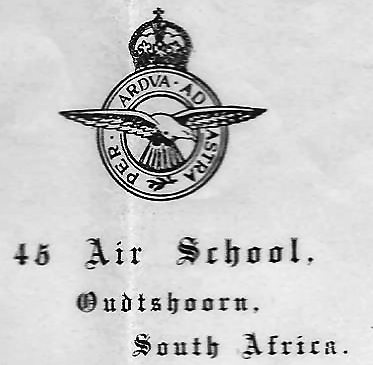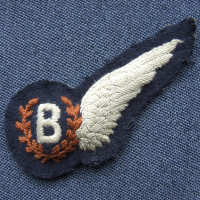Chapter 4 - Aircrew Training
Stephen's service record shows that he received training to become an Observer in South Africa. It transpires that aircrew training in South Africa was brought about by an agreement first suggested on 13th December 1939 when General Smuts offered his facilities for British Subjects (but only of European Descent) who were living at that time in South Africa. On the 5th January 1940 his proposal was accepted by the United Kingdom but asked that it be extended to pupils from the UK. It was asked that the "Union" act as UK agents such that there would be no British Training Organisation. Smuts acquiesced. The arrangement became known as the Empire Air Training Scheme and then later as the British Commonwealth Air Training Plan
Each of the training centres was given the title "Air School". Of those attended by Stephen, 75 Air School was located at Lyttelton in the outskirts of Pretoria. His record of service does not identify the dates between which Stephen attended 75 Air School and it is not clear what training was received. Examination of Air 54/183 at the National Archives suggests that Stephen will have been subject to aptitude tests such as "Skill", "Ambidextrous", "Steadiness", "Attention", "Temperament", and "Distraction".
A month later, he moved to 45 Air School on 12th March 1942. This training took place at Oudtsshoorn, about 200 miles east of Cape Town, providing training in "A.O.N.S & B & GS" which translates to Air Observers Navigation School, and Bombing & Gunnery School. The records indicate that 45 Air School did not actual provide armament training which may explain Stephen's participation at No44 Air School. This was an Air Gunnery School and was based at Grahamstown being about 70 miles North East of Port Elizabeth. Other records suggest that 44 Air school concentrated on Navigation and Bombing. In any event during his time in South Africa, Stephen will have been trained in the single engine Fairey Battle light bomber, and the twin engined Airspeed AS.10 Oxford, and Avro Anson.
Further understanding of Stephen's training can be gleaned from a letter sent by him to his long-standing friend Martin Hartley. The document has been kindly provided in 2016 by his sons Andrew and Peter. Their father had been in the retreat from Dunkirk before being posted to Kenya, Abyssinia (Ethiopia), and Madagascar. He survived the war making a career in banking. He died in 1994.
The letter, together with its envelope can be viewed here. The text is as follows:
|
July 2 (42) Dear Martin, Well my old friend how are you? I am also employed in this vast continent, although some distance from you unfortunately. I do not seem to have seen you for years. I was sent out here to complete training as a navigator cum wireless operator cum bomb aimer cum air gunner. Unfortunately the theory of navigation proved too difficult to absorb in the limited time available and I failed my final examination. We.... The page has been cut here, presumably by the censor. I am now trying to get straight to an elementary flying school to take a pilots course as I think I will be accepted in this country and as I have quite a little flying experience. There is very little fun in flying in wartime as I have already discovered, particularly in this part of the world where we are surrounded by high mountains and on occasions run into colossal air currents which make flying dangerous. I will tell you of one experience I had. I was first navigator some 6 weeks ago on a 3 hour skeleton map exercise. I cannot give you any details of the exercise but briefly the idea is, the pilot endeavours to loose you and after a period of some 2 1/2 hours requests his position and a course to base. The trip started quite uneventfully except that the met. forecast stated that at 8000 feet the wind was approaching 60 MPH and conditions were likely to be bumpy. For the first hour things were quite happy except for slight bumpiness. Then gradually conditions got worse and we were pitching about all over the place. Just before I was due to give the pilot a course for home WHMPH !! and myself and the second navigator were shot right through the plywood roof. The next I knew I was practically sitting on top of the plane. Then I fell back smash on top of the pilot. Well I would say this, we had with us the finest pilot on the camp, and we needed him. He was not even shaken and he fought with that plane like you see cowboys fighting with bucking broncos. We got back OK although we were cut about the face a bit. I discovered afterwards we had dropped 1500 feet which is very nearly but not quite a station record. However these conditions are fairly rare (known as burgh wind conditions) and for the most part flying is not too bad. I have heard all sorts of music here as we have formed a musical circle and go to quite a number of private houses. This last weekend I spent with one, Mrs Bridgemond. Her husband has a speaker much like Billy's which he made himself. For two whole days I feasted myself on Elgar's 2nd Symphony, Brahms Variations, Cesar Franck's Symphony, Elgar's Dream of Gerontius, Mozart's G Major Symphony and Night Music, Schubert's "Heavenly Song", and some lovely odds and ends like Delius' Summer Garden, First Cuckoo, Debussy's Submerged Cathedral. I could almost weep at these poignant little reminders of what has gone and wonder at the futility of the whole war. A friend of mine here is a chap called Herbert, organist from Truro Cathedral and also a brilliant pianist. I am afraid they won't make an observer of him either. Well must go now. Keep the old chin up, you've always been my best friend you know, deep down.
|
The date, 2nd July, on the original letter has '42 hand written against it. The envelope bears a post mark of 3rd August 1942 possibly when it was re-directed. Clearly Stephen did not realise his wish to become a pilot and was to graduate as an observer. A note in his mother's handwriting suggests that he may have later been trained as second pilot. His love of classical music, shared by Martin, must have been a great comfort to him. To date it has not been possible to trace details of Herbert, his friend in South Africa.
On the 12th December 1942 Stephen's record shows that he was promoted to the rank of Sergeant (a fact that would suggest completion of training on that date). Two months later, the record shows that he disembarked in the UK through 7 Personnel Reception Centre, Harrogate. It would seem that during this period the Reception Centre was located in the Majestic Hotel. So far, it has not been possible to identify the means by which Stephen travelled from South Africa to Britain. Harrogate would have been especially convenient for Stephen whose family was based in nearby Ilkley.

Three photographs of adult Stephen survive to this day. The first shows Stephen sitting between his twin sister Margaret, and his brother Bill. All are wearing their uniforms. Margaret as a WREN, Bill as a member of the Home Guard and Stephen in a number 1 uniform of the Royal Air Force proudly bearing the rank of sergeant with his no doubt treasured Observer brevet. At about this time the Royal Air Force reviewed the roles of aircrew to account for larger bombers which required more crew members with more defined responsibilities. Having been trained as an Observer in South Africa, he was subsequently trained as a Bomb Aimer.
|
|
|
These two brevets are thought to have been recovered from Stephen's personal possessions

The other two photos show Stephen in civilian clothes, one with a pipe. The photo mounts, the backgrounds and the inevitable desire of parents at that time to seize any opportunity to get photographs of sons and daughters would suggest that all three were taken at the same time.


